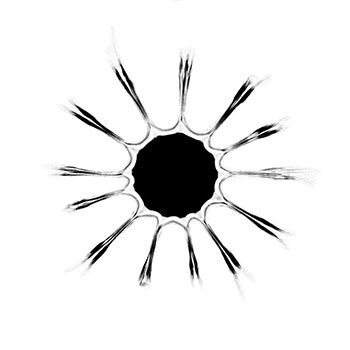What special equipment is placed inside the heart and used as an impulse generator to make the heart function?
1 Answer
That special equipment is called the "Pacemaker."
Explanation:
What is a pacemaker insertion?
A pacemaker insertion is the implantation of a small electronic device that is usually placed in the chest (just below the collarbone) to help regulate slow electrical problems with the heart. A pacemaker may be recommended to ensure that the heartbeat does not slow to a dangerously low rate.
Cross-section of the heart showing the electrical pathways
Click image to enlarge
The heart's electrical system
The heart is basically a pump made up of muscle tissue that is stimulated by electrical currents, which normally follow a specific circuit within the heart.
This normal electrical circuit begins in the sinus or sinoatrial (SA) node, which is a small mass of specialized tissue located in the right atrium (upper chamber) of the heart. The SA node generates an electrical stimulus at 60 to 100 times per minute (for adults) under normal conditions; this electrical impulse from the SA node starts the heartbeat.
The electrical impulse travels from the SA node via the atria to the atrioventricular (AV) node in the bottom of the right atrium. From there the impulse continues down an electrical conduction pathway called the Bundle of His and then on through the "His-Purkinje" system into the ventricles (lower chambers) of the heart. When the electrical stimulus occurs it causes the muscle to contract and pump blood to the rest of the body. This process of electrical stimulation followed by muscle contraction is what makes the heart beat.
A pacemaker may be needed when problems occur with the electrical conduction system of the heart. When the timing of the electrical stimulation of the heart to the heart muscle and the subsequent response of the heart's pumping chambers is altered, a pacemaker may help.
What is a pacemaker?
A pacemaker is composed of three parts: a pulse generator, one or more leads, and an electrode on each lead. A pacemaker signals the heart to beat when the heartbeat is too slow or irregular.
A pulse generator is a small metal case that contains electronic circuitry with a small computer and a battery that regulate the impulses sent to the heart.
A pacemaker and it's position in the chest
Click image to enlarge
The lead (or leads) is an insulated wire that is connected to the pulse generator on one end, with the other end placed inside one of the heart's chambers. The lead is almost always placed so that it runs through a large vein in the chest leading directly to the heart. The electrode on the end of a lead touches the heart wall. The lead delivers the electrical impulses to the heart. It also senses the heart's electrical activity and relays this information back to the pulse generator. Pacemaker leads may be positioned in the atrium (upper chamber) or ventricle (lower chamber) or both, depending on the medical condition.
If the heart's rate is slower than the programmed limit, an electrical impulse is sent through the lead to the electrode and causes the heart to beat at a faster rate.
When the heart beats at a rate faster than the programmed limit, the pacemaker generally monitors the heart rate and will not pace. Modern pacemakers are programmed to work on demand only, so they do not compete with natural heartbeats. Generally, no electrical impulses will be sent to the heart unless the heart's natural rate falls below the pacemaker's lower limit.
A newer type of pacemaker, called a biventricular pacemaker, is currently used in the treatment of specific types of heart failure. Sometimes in heart failure, the two ventricles do not pump in a normal manner. Ventricular dyssynchrony is a common term used to describe this abnormal pumping pattern. When this happens, less blood is pumped by the heart. A biventricular pacemaker paces both ventricles at the same time, increasing the amount of blood pumped by the heart. This type of treatment is called cardiac resynchronization therapy or CRT.
After a pacemaker insertion, regularly scheduled appointments will be made to ensure the pacemaker is functioning properly. The doctor uses a special computer, called a programmer, to review the pacemaker's activity and adjust the settings when needed.
Other related procedures that may be used to assess the heart include resting and exercise electrocardiogram (ECG), Holter monitor, signal-averaged ECG, cardiac catheterization, chest X-ray, computed tomography (CT scan) of the chest, echocardiography, electrophysiology studies, magnetic resonance imaging (MRI) of the heart, myocardial perfusion scan (stress), myocardial perfusion scan (resting), radionuclide angiography, and cardiac CT scan.
Note that although an MRI is a very safe procedure, the magnetic fields used by the MRI scanner may interfere with the pacemaker's function. Any patient with a pacemaker should always speak with his or her cardiologist before undergoing an MRI.

